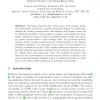Free Online Productivity Tools
i2Speak
i2Symbol
i2OCR
iTex2Img
iWeb2Print
iWeb2Shot
i2Type
iPdf2Split
iPdf2Merge
i2Bopomofo
i2Arabic
i2Style
i2Image
i2PDF
iLatex2Rtf
Sci2ools
130
Voted
MICCAI
2004
Springer
2004
Springer
Construction of 3D Dynamic Statistical Deformable Models for Complex Topological Shapes
Abstract. This paper describes the construction of 3D dynamic statistical deformable models for complex topological shapes. It significantly extents the existing framework in that surfaces with higher genus can be effectively modeled. Criteria based on surface conformality and minimum description length is used to simultaneously identify the intrinsic global correspondence of the training data. The proposed method requires neither surface partitioning nor artificial grids on the parameterization manifold. The strength of the method is demonstrated by building a statistical model of the complex anatomical structure of the left side of human heart that includes the left ventricle, left atrium, aortic outflow tract, and pulmonary veins. The analysis of variance and leave-one-out-cross-validation indicate that the derived model not only captures physiologically plausible modes of variation but also is robust and concise, thus greatly enhancing its potential clinical value.
Aortic Outflow Tract | Complex Topological Shapes | Left Ventricle | Medical Imaging | MICCAI 2004 |
Related Content
| Added | 15 Nov 2009 |
| Updated | 15 Nov 2009 |
| Type | Conference |
| Year | 2004 |
| Where | MICCAI |
| Authors | Paramate Horkaew, Guang-Zhong Yang |
Comments (0)

